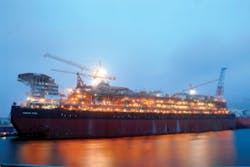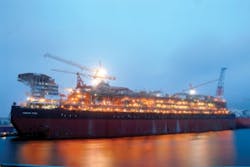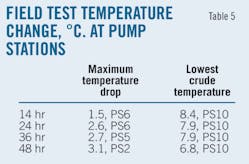BP PLC started drilling a relief well as one of several options the company is pursuing to kill a deepwater blowout in the Gulf of Mexico and stop a widening crude oil leak that has caused international concern.
Subsea options involve activating an apparently malfunctioning blowout preventer (BOP), installing a collection system to catch leaking oil, and injecting chemical dispersants onto the oil at the wellhead.
Surface spill responses include controlled burns, dispersants, and skimmers and booms to keep the oil from reaching the coasts of Louisiana, Mississippi, Alabama, and Florida.
Transocean Ltd.'s Deepwater Horizon semisubmersible, which drilled the runaway Macondo well, exploded and burned on Apr. 20, leaving 11 workers missing and presumed dead. The Deepwater Horizon sank in 5,000 ft of water on Apr. 22 (OGJ, May 3, 2010, p. 31).
The well had struck oil and gas. The oil being spilled is 35º gravity and sweet, said BP, which is spending an estimated $6 million/day on spill response.
BP operates Mississippi Canyon Block 252 and owns 65% working interest. Anadarko Petroleum Corp. owns 25%, and Mitsui Oil Exploration Co. Ltd. owns 10%.
Cause of the accident remains under investigation by various companies and government agencies. BP sought advice from other oil companies.
A National Response Team involving 16 federal departments and agencies along with BP is handling efforts to control the spill.
Federal officials, including President Barack Obama, visited the Gulf Coast seeking a faster resolution of the oil spill. The slick forced shutdown of two production platforms and evacuation of one of them, halting production of 6.2 MMcfd of natural gas (OGJ Online, May 1, 2010).
Federal officials
The US Department of the Interior established an Outer Continental Shelf Safety Board to review offshore drilling practices and safety issues and to tighten oversight of equipment testing, if needed.
Interior Sec. Ken Salazar met with oil industry executives in Houston before he met with spill response officials in Louisiana (OGJ Online, Apr. 30, 2010).
Salazar plans to report to Obama by May 31 about the safety of deepwater oil and gas operations.
"We cannot rest until BP permanently seals the wellhead and until we clean up every drop of oil," he said. "This has huge ramifications about what happens to energy development in the ocean all around the world."
Obama toured a US Coast Guard station in Venice, La., where he called the spill a "massive and potentially unprecedented environmental disaster (OGJ Online, May 2, 2010)."
"BP is responsible for this leak," Obama said. "BP will be paying the bill…. From day one…we have prepared for the worst while we have hoped for the best."
BP Group Chief Executive Tony Hayward said, "BP will do anything and everything we can to stop the leak, attack the spill offshore, and protect the shorelines of the gulf coast."
Hayward said BP teams "are working hand in hand" with government oil spill response teams.
Interior Secretary Salazar, Department of Homeland Security Secretary Janet Napolitano, and Environmental Protection Agency Administrator Lisa Jackson inspected Gulf Coast response efforts to minimize environmental risks to coastal communities.
The officials also initiated daily calls with governors from the states involved.
Federal officials authorized the use of up to 17,500 National Guard members total in Alabama, Florida, Louisiana, and Mississippi.
Halliburton comments
Halliburton provided cementing services for the Deepwater Horizon and is cooperating with investigations into the accident.
Four Halliburton employees safely got off the rig.
"Halliburton continues to assist in efforts to identify the factors that may have led up to the disaster, but it is premature and irresponsible to speculate on any specific causal issues," it said in an Apr. 30 news release.
Tests demonstrated the integrity of the production casing string before the accident, Halliburton said.
"Halliburton had completed the cementing of the final production casing string in accordance with the well design approximately 20 hr prior to the incident," the company said. "The cement slurry design was consistent with that utilized in other, similar applications."
At the time of the rig explosion and fire, well operations had not yet reached the point requiring the placement of the final cement plug that would enable the planned temporary abandonment of the well, Halliburton said.
Stemming leaks
Initially, the spill estimate was 1,000 b/d. But Coast Guard Rear Adm. Mary Landry and BP increased the estimate to 5,000 b/d.
Officials first reported leaks from the wellhead and riser. A second leak also was reported from the riser.
On May 6, BP stopped one of the leaks by installing a shutoff valve atop the drill pipe.
Doug Suttles, chief operating officer of BP Exploration & Production Inc., said the spill rate was expected to still be 5,000 b/d even though one source had been shut off.
Meanwhile, Transocean's Development Drilling III semisubmersible started drilling a relief well on May 2. The well is expected to take 3 months to drill to the target depth of 13,000 ft below the seabed.
Heavy drilling fluids, and ultimately cement, will be used to stop the flow through the first well. A second relief well is being planned.
Containment system
Spill response officials estimate a subsea containment system could collect as much as 85% of the oil rising from the seafloor.
The system involves a metal structure designed to collect oil and gas, which then will be pumped to Transocean's Discoverer Enterprise drillship.
The containment structure will be set on top of the end of the riser about 600 ft from the wellhead. The containment structure was en route to Mississippi Canyon Block 252 on May 5.
Suttles said the subsea containment system could be installed and operating as soon as May 10. But he noted that such a system never has been used in 5,000 ft, where pressure is 2,500 psi.
"There are a number of challenges," he said. "This hasn't been done before, and it's very complex."
BP plans to connect the subsea container to a riser through which fluids will flow to the Discoverer Enterprise, where oil will be separated from water and gas.
The Discoverer Enterprise is capable of processing 15,000 b/d of oil and storing 139,000 bbl. A support barge will be deployed. The barge can hold 137,000 bbl.
BOP work
Meanwhile, Suttles said efforts continued to activate the BOP.
"We will not stop until we have exhausted every opportunity," to stem the flow via the BOP, which is the fastest solution available, Suttles said.
Deepwater Horizon crew members reported they manually tried to activate the BOP before they left the semi, Suttles said. Since then, workers have tried to activate the BOP from subsea access points.
Nine remotely operated vehicles are being used to monitor the leaks, to try to activate the BOP, to install the valve on the drill pipe, and to spray chemical dispersants into the oil at the seabed level, Suttles said.
BP asked the Department of Defense if it had better ROVs than what is commercially available. BP also asked DOD for help with imaging.
Burns, dispersants used
Workboats consolidated areas of emulsified oil into a 500-ft fire-resistant boom. The boom and oil then are towed to a more remote area where the oil was ignited.
About 100 gal was burned in an initial test burn on Apr. 28, but then burning had to be stopped because of high winds and choppy seas.
Calm weather enabled controlled burns to resume on May 5. Officials expected each burn could involve 500-1,000 bbl.
No populated areas were expected to be affected by the controlled burn operations, and there were no anticipated impacts to marine mammals and sea turtles, the Coast Guard said. Landry said May 5 that officials had not confirmed that any oil had reached shore despite earlier projections that oil might reach Louisiana in the Mississippi River Delta on Apr. 30. A shift in wind and waves apparently kept the oil offshore.
"We have been given a gift of time," Landry said. The leading edge of the spill is a rainbow sheen consisting of an oil and water mixture, she said.
Spill response officials received approvals from the National Oceanic and Atmospheric Administration and the US Minerals Management Service to try applying dispersants in the ocean.
Subsea dispersants
In two test applications, BP used coiled tubing and ROVs to apply dispersants at the wellhead. It's the first time this strategy has been used in 5,000 ft of water. As expected, the subsea application of dispersants temporarily was halted on May 5 pending a study of effectiveness.
On the gulf's surface, DOD provided C-130 aircraft with modular aerial spay systems to dispense chemical dispersants. The Navy provided various oil pollution control equipment, including thousands of feet of inflatable boom with mooring equipment.
MMS inspections
MMS is reviewing records of all Gulf of Mexico drilling contractors and operators to ensure they are periodically checking that BOPs are working (OGJ, Online, Apr. 29, 2010).
Routinely, BOPs are to be checked about every 2 weeks, and companies are to keep records of these inspections on file.
MMS inspectors first checked the records of drilling rigs and then planned to check the records of production platforms.
Lars Herbst, MMS regional director for the Gulf of Mexico region, has said the agency wants to ensure that all the proper testing has been done on the BOPs.
The MMS and USCG have issued a safety alert asking operators and drilling contractors to inspect their equipment and review their procedures.
Among a list of safety recommendations issued Apr. 30, the MMS and USCG asked operators and contractors to examine all well-control equipment (surface and subsea) to ensure that it had been properly maintained.
The agencies also asked that all rig drilling, casing, and completion practices be reviewed to ensure that well-control contingencies are not compromised at any point while the BOP is installed on the wellhead. They also asked operators and contractors to review all emergency shutdown and dynamic positioning procedures that interface with emergency well-control operations.
EPA monitoring
The EPA worked with state and local governments on air and water monitoring to determine any aftermath from the oil spill or from the controlled burns on the open water.
The agency said it was tracking levels of particulate matter and ozone along the gulf coast.
"We are taking every possible step to protect the health of the residents and mitigate the environmental impacts of this spill," EPA's Jackson said.
She also said she wanted the expertise of local coastal residents "who know these marshes like the back of their hand."
EPA established air-monitoring stations along Plaquemines Parish on the Louisiana coast. EPA established those facilities to determine how oil set on fire in the gulf and oil reaching land affects air quality.
In addition, EPA is monitoring levels of a number of chemicals potentially emitted by oil, including volatile organic compounds such as xylene, benzene, and toluene.
EPA has deployed two trace atmospheric gas analyzers, mobile laboratories that collect and analyze air-quality samples in real time, to monitor air quality in the region.
The agency established a web site to report the spill's impact on the environment and the health of coastal residents.
On May 2, NOAA restricted commercial and recreational fishing for a minimum of 10 days in federal waters largely between Louisiana state waters at the mouth of the Mississippi River to waters off Florida's Pensacola Bay.
More Oil & Gas Journal Current Issue Articles
More Oil & Gas Journal Archives Issue Articles
View Oil and Gas Articles on PennEnergy.com




